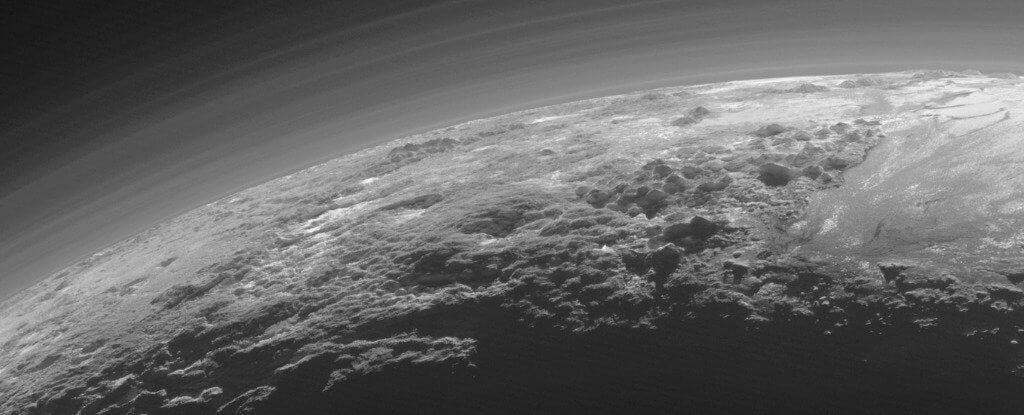
Pluto was considered the farthest planet in the Solar system, was downgraded in status and transferred to the class of dwarf planets the International astronomical Union in 2006 in connection with the opening of many new Kuiper belt objects, similar to them in size. But despite that, this miniature world remains of great scientific interest. After all, even the spacecraft New horizons, which flew past this planetary object in July 2015, could not reveal all its secrets.
Moreover, the continued analysis of the data with the “New horizons” gives rise to new puzzles. Recently, a group of astronomers stated that x-ray space Observatory Chandra have discovered the presence of a fairly strong x-ray radiation coming from Pluto. For scientists, this was so unexpected that actually force us to reconsider our knowledge about the atmosphere of Pluto and its interaction with the solar wind.
In the past researchers have observed x-ray emission around many objects in the Solar system. The reason for this phenomenon, as a rule, is the result of the interaction of the solar wind and neutral gases such as argon and nitrogen. For example, such radiation has been discovered at Venus and Mars. Because the atmosphere contains these elements. However, the same phenomenon can be observed in a more compact space objects such as comets, which often have lights (so-called halos) caused by degassing.
After the flight of New horizons past Pluto in 2015 even more astronomers began to suspect that Pluto has an atmosphere, which varies in density and size with the changing seasons. When the planet reaches perihelion (nearest point of orbit to the Sun) in the part of its 248-year orbital period, the distance between Pluto and the Sun is 4 436 820 000 kilometers. At this point, the dwarf planet’s atmosphere becomes denser due to evaporation of melting of nitrogen and methane on its surface under the influence of the radiation of the stars.
The last time Pluto was in the point of perihelion on 5 September 1989. That is, when the “New horizons” reached the planet Pluto, we can say, it was still summer. Studying Pluto, the probe confirmed that the planet’s atmosphere consists mainly of gases such as nitrogen, methane and carbon dioxide.
Next, the astronomers decided for fun to take a look at the dwarf planet using orbiting x-ray telescope “Chandra” and look for the signs of x-ray radiation coming from its atmosphere. Before the visit to Pluto “New horizons” most computer models of the atmosphere of Pluto told us that although she is exhausted, but has a greater extent. However the probe it was found that it is thinner and the loss of its material hundreds of times lower than expected by the model.
In the results of their study, the researchers indicate that expect to see the emission of x-rays that are consistent with what was observed by the apparatus “New horizons” in the planet’s atmosphere. However, check with Chandra revealed a higher background x-ray radiation of Pluto, which is not consistent with the state, which is its atmosphere. It should be noted that scientists have already seen how little space objects in the Solar system have demonstrated strong x-ray radiation, which was explained by the interaction of solar x-ray particles of dust rich in carbon, nitrogen and oxygen, surrounding such objects. But if we talk about Pluto, this explanation does not fit.
At the moment the only assumption of scientists is the existence of a process (or processes), forcing you to concentrate the amount of solar particles near Pluto, thereby the activity is very modest atmosphere of the dwarf planet.
“The observed emission of the Pluton is not related to its luminosity. If it was in the light diffusion here would be to source the unique combination of nanoparticles of dust, nitrogen, oxygen and methane, to obtain such an effect of fluorescence under sunlight. If we were talking about the transfer of charge between particles of the solar wind and neutral gas (mostly methane) evaporating from Pluto, we should adjust our models relative to that of the excess ions of the solar wind, which interact with other particles near the planet.”
In other words, scientists want to say that the source of this x-ray radiation remains for them a mystery. For the sake of completeness requires the study of other remote and similar massive objects in the Kuiper belt that was with what to compare. Fortunately, the data provided by the spacecraft New horizons will analyze for decades to come. Who knows what else may they be hiding, as regards Pluto, and as a whole on the outer limits of the Solar system.
The study, whose results were accepted for publication in a scientific journal Icarus, was conducted by astronomers from the applied physics Laboratory of Johns Hopkins University, Harvard-Smithsonian center for astrophysics, southwest research Institute, Space center Vikram Sarabhai (India) and the jet propulsion Laboratory of NASA.
Astronomers told about another interesting puzzle Pluto
Nikolai Khizhnyak